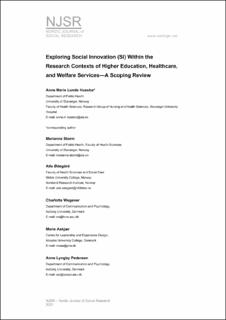| dc.contributor.author | Husebø, Anne Marie Lunde | |
| dc.contributor.author | Storm, Marianne | |
| dc.contributor.author | Ødegård, Atle | |
| dc.contributor.author | Wegener, Charlotte | |
| dc.contributor.author | Aakjær, Marie | |
| dc.contributor.author | Pedersen, Anne Lyngby | |
| dc.contributor.author | Østergaard, Maja Boelsmand | |
| dc.contributor.author | Willumsen, Anna Elisabeth | |
| dc.date.accessioned | 2022-12-07T14:33:34Z | |
| dc.date.available | 2022-12-07T14:33:34Z | |
| dc.date.created | 2021-02-22T11:13:01Z | |
| dc.date.issued | 2021 | |
| dc.identifier.citation | Nordic Journal of Social Research. 2021, 12 (1), 72-110. | en_US |
| dc.identifier.issn | 1892-2783 | |
| dc.identifier.uri | https://hdl.handle.net/11250/3036443 | |
| dc.description.abstract | ntroduction: Nordic countries face societal challenges for which social innovation may represent solutions. The aim of this scoping review is to explore the concept of social innovation within the research contexts of higher education, ealthcare, and welfare services. Method: A scoping review methodology was used, including a literature search and the identification of eligible studies published between 2007 and 2019, in addition to data extraction and synthesis. Forty-three studies were included in this review. Results: Across the research contexts, social innovation is conceptualized as a set of novel, creative, human-centred, and value-driven processes aiming to bring about change. Qualitative research methods dominate social innovation research. In welfare services, social innovation concerns the relationship between policy and praxis, new forms of leadership and management, and the promotion of societal inclusion and cohesion. Social innovation in healthcare comprises the use of technology to digitalize service, enhance patients’ well-being, and improve service quality. In higher education, social innovation research focuses on educational reforms involving non-profit stakeholders. Discussion: Social innovation is a multifaceted concept related to change at the organizational or societal level, often with various stakeholders working together to create improvements. The lack of a common definition and framework of social innovation makes this concept difficult to measure or quantify, reflecting the dominance of qualitative research methods in the selected research contexts. Across these research contexts, social innovation can be defined and used for various research purposes, which are often political and value-based, with the latter connected to the common good and people’s well-being. Moreover, few social innovation studies have been performed in Nordic countries. | en_US |
| dc.language.iso | eng | en_US |
| dc.relation.uri | https://doi.org/10.7577/njsr.3455 | |
| dc.rights | Navngivelse 4.0 Internasjonal | * |
| dc.rights.uri | http://creativecommons.org/licenses/by/4.0/deed.no | * |
| dc.title | Exploring social innovation (SI) within the research contexts of higher education, healthcare and welfare services : a scoping review | en_US |
| dc.type | Peer reviewed | en_US |
| dc.type | Journal article | en_US |
| dc.description.version | publishedVersion | en_US |
| dc.source.pagenumber | 72-110 | en_US |
| dc.source.volume | 12 | en_US |
| dc.source.journal | Nordic Journal of Social Research | en_US |
| dc.source.issue | 1 | en_US |
| dc.identifier.doi | 10.7577/njsr.3455 | |
| dc.identifier.cristin | 1892248 | |
| cristin.ispublished | true | |
| cristin.fulltext | original | |
| cristin.qualitycode | 1 | |

